Blog - Foot Doctor, Chambersburg and McConnellsburg, PA
How Can Diabetic Patients Check the Soles of Their Feet?

Diabetes is a serious condition and can lead to complications regarding the feet if not under the care of a podiatrist. Elevated blood sugar levels may lead to the inability to feel existing cuts on the feet. These can easily develop into foot ulcers and may be controlled by implementing healthy lifestyle habits. Drinking plenty of water daily, reducing sugar intake, and practicing a gentle exercise regime are a few ways that can guide the diabetic person to possibly feeling better. It is necessary to pay close attention to the feet, and the soles can be inspected daily by using a mirror. This is an effective method for noticing any cuts, bruises, or scrapes that have developed, and they may be easier to see than to feel. Good foot hygiene consists of trimming the toenails weekly, which is often performed by a podiatrist. Diabetic patients may notice the skin on their feet is excessively dry and cracked, which may indicate additional foot problems. If you have diabetes, it is strongly advised that you are under the care of a podiatrist who can treat this ailment, and help you manage it.
Diabetic foot care is important in preventing foot ailments such as ulcers. If you are suffering from diabetes or have any other concerns about your feet, contact Dr. Steven Schwartz from Pennsylvania. Our doctor can provide the care you need to keep you pain-free and on your feet.
Diabetic Foot Care
Diabetes affects millions of people every year. The condition can damage blood vessels in many parts of the body, especially the feet. Because of this, taking care of your feet is essential if you have diabetes, and having a podiatrist help monitor your foot health is highly recommended.
The Importance of Caring for Your Feet
- Routinely inspect your feet for bruises or sores.
- Wear socks that fit your feet comfortably.
- Wear comfortable shoes that provide adequate support.
Patients with diabetes should have their doctor monitor their blood levels, as blood sugar levels play such a huge role in diabetic care. Monitoring these levels on a regular basis is highly advised.
It is always best to inform your healthcare professional of any concerns you may have regarding your feet, especially for diabetic patients. Early treatment and routine foot examinations are keys to maintaining proper health, especially because severe complications can arise if proper treatment is not applied.
If you have any questions please feel free to contact our offices located in Chambersburg, and Mcconnellsburg, PA . We offer the newest diagnostic and treatment technologies for all your foot and ankle needs.
Toe Problems and Arthritis
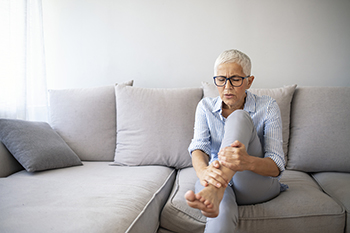 Anyone who suffers from arthritis likely knows that their condition can significantly affect their feet in many different ways. If you are living with arthritis, it might be helpful to be aware of how this condition can impact your toes. For example, arthritis may affect the joints of the toes, particularly the big toe. Also, swelling around the toe joints can occur. Restricted motion of the big toe may also be a symptom of your arthritis. Perhaps the big toe is stuck in a position and moving it can be difficult. It is also important to note that many different kinds of arthritis can affect the toes. Notably, osteoarthritis, rheumatoid arthritis, psoriatic arthritis, gout, and other kinds of arthritis can impact the toes. If you suffer from arthritis, schedule an appointment with a podiatrist today for guidance.
Anyone who suffers from arthritis likely knows that their condition can significantly affect their feet in many different ways. If you are living with arthritis, it might be helpful to be aware of how this condition can impact your toes. For example, arthritis may affect the joints of the toes, particularly the big toe. Also, swelling around the toe joints can occur. Restricted motion of the big toe may also be a symptom of your arthritis. Perhaps the big toe is stuck in a position and moving it can be difficult. It is also important to note that many different kinds of arthritis can affect the toes. Notably, osteoarthritis, rheumatoid arthritis, psoriatic arthritis, gout, and other kinds of arthritis can impact the toes. If you suffer from arthritis, schedule an appointment with a podiatrist today for guidance.
Arthritis can be a difficult condition to live with. If you are seeking treatment, contact Dr. Steven Schwartz from Pennsylvania. Our doctor can provide the care you need to keep you pain-free and on your feet.
Arthritic Foot Care
Arthritis is a joint disorder that involves the inflammation of different joints in your body, such as those in your feet. Arthritis is often caused by a degenerative joint disease and causes mild to severe pain in all affected areas. In addition to this, swelling and stiffness in the affected joints can also be a common symptom of arthritis.
In many cases, wearing ill-fitting shoes can worsen the effects and pain of arthritis. Wearing shoes that have a lower heel and extra room can help your feet feel more comfortable. In cases of rheumatoid arthritis, the arch in your foot may become problematic. Buying shoes with proper arch support that contour to your feet can help immensely.
Alleviating Arthritic Pain
- Exercises that stretch the foot can prevent further pain and injury and increase mobility
- Most of the pain can be alleviated with anti-inflammatory drugs, heat, and topical medications
- Massages can help temporarily alleviate pain.
It is best to see your doctor for the treatment that is right for your needs and symptoms. Conditions vary, and a podiatrist can help you determine the right method of care for your feet.
If you have any questions, please feel free to contact our offices located in Chambersburg, and Mcconnellsburg, PA . We offer the newest diagnostic tools and technology to treat your foot and ankle needs.
Ways to Treat Toenail Fungus

There are various ailments that can affect the toenails, and toenail fungus is considered to be the most common. Research has indicated that approximately 10 percent of adults suffer from this type of infection, and it can affect both feet. Common symptoms include yellowed toenails that can become brittle and may ultimately fall off. Toenail fungus is known to be challenging to treat, and often requires medical attention. The fungus that causes this unsightly condition lives and thrives in warm and moist environments, such as locker rooms, public swimming pools, and shower room floors. It can enter the body through small cuts in the feet of which the patient may be unaware of. Toenail fungus may easily be avoided when specific prevention methods are consistently followed. Wearing socks that are made of breathable materials, trimming the toenails correctly, and avoiding sharing shoes and socks may help in eliminating toenail fungus. Additionally, it is extremely beneficial to wear appropriate shoes while in these areas, which often includes flip flops or water shoes. If you are affected by toenail fungus, please consult a podiatrist who can effectively treat this condition.
For more information about treatment, contact Dr. Steven Schwartz of Pennsylvania. Our doctor can provide the care you need to keep you pain-free and on your feet.
Toenail Fungus Treatment
Toenail fungus is a condition that affects many people and can be especially hard to get rid of. Fortunately, there are several methods to go about treating and avoiding it.
Antifungals & Deterrence
Oral antifungal medicine has been shown to be effective in many cases. It is important to consult with a podiatrist to determine the proper regiment for you, or potentially explore other options.
Applying foot powder on the feet and shoes helps keep the feet free of moisture and sweat.
Sandals or open toed shoes – Wearing these will allow air movement and help keep feet dry. They also expose your feet to light, which fungus cannot tolerate. Socks with moisture wicking material also help as well.
If you have any questions please feel free to contact our offices located in Chambersburg, and Mcconnellsburg, PA . We offer the newest diagnostic tools and technology to treat your foot and ankle needs.
Foot Problems Common to Seniors
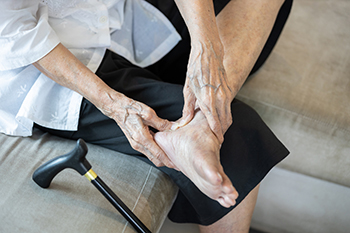
Foot pain in seniors often interferes with daily activities, such as walking, climbing stairs, and even getting out of a chair. It may also affect the balance, which increases the likelihood of falling. Further, movement difficulty contributes to muscle weakness, weight gain, and diminished heart function. One of the most common causes of foot pain in seniors is wearing shoes that do not fit properly. It is believed that three-fourths of seniors over 65 wear shoes that are too small for their feet. In addition, narrow shoes and high-heels, along with footwear that lacks the proper support, contribute to pain, injuries, and risk of falling. Other common types of foot pain in older adults include bunions, calluses and corns, hammertoe, toenail problems, and heel problems. Additional causes are diabetes-related foot problems, such as ulcers and wounds that will not heal, and arthritis-related toe problems, such as gout. If you are experiencing foot pain that inhibits your life, please consult with a podiatrist for an examination and suggested treatment options.
Proper foot care is something many older adults forget to consider. If you have any concerns about your feet and ankles, contact Dr. Steven Schwartz from Pennsylvania. Our doctor can provide the care you need to keep you pain-free and on your feet.
The Elderly and Their Feet
As we age we start to notice many changes in our body, but the elder population may not notice them right away. Medical conditions may prevent the elderly to take notice of their foot health right away. Poor vision is a lead contributor to not taking action for the elderly.
Common Conditions
- Neuropathy – can reduce feeling in the feet and can hide many life-threatening medical conditions.
- Reduced flexibility – prevents the ability of proper toenail trimming, and foot cleaning. If left untreated, it may lead to further medical issues.
- Foot sores – amongst the older population can be serious before they are discovered. Some of the problematic conditions they may face are:
- Gouging toenails affecting nearby toe
- Shoes that don’t fit properly
- Pressure sores
- Loss of circulation in legs & feet
- Edema & swelling of feet and ankles
Susceptible Infections
Diabetes and poor circulation can cause general loss of sensitivity over the years, turning a simple cut into a serious issue.
If you have any questions please feel free to contact our offices located in Chambersburg, and Mcconnellsburg, PA . We offer the newest diagnostic and treatment technologies for all your foot and ankle needs.
Proper Form, Exercises, and Shoes May Help to Prevent Running Injuries

People who enjoy the sport of running are all too familiar with attempting to prevent running injuries. This may be accomplished by performing proper strength training exercises, in addition to wearing the right shoes and having proper form. Research has shown the number of running injuries that are encountered may be related to how many injuries have happened in the past, in addition to possibly having foot problems. Many people get hurt as a result of increasing speed and mileage too quickly, in addition to not warming up and cooling down properly. Performing strength training exercises for the feet and body may help considerably reduce the number of running injuries. If you are interested in learning more about how running injuries can affect the feet and how to prevent them, please consult with a podiatrist.
All runners should take extra precaution when trying to avoid injury. If you have any concerns about your feet, contact Dr. Steven Schwartz of Pennsylvania. Our doctor will treat your foot and ankle needs.
How to Prevent Running Injuries
There are a lot of mistakes a runner can make prior to a workout that can induce injury. A lot of athletes tend to overstretch before running, instead of saving those workouts for a post-run routine. Deep lunges and hand-to-toe hamstring pulls should be performed after a workout instead of during a warmup. Another common mistake is jumping into an intense routine before your body is physically prepared for it. You should try to ease your way into long-distance running instead of forcing yourself to rush into it.
More Tips for Preventing Injury
- Incorporate Strength Training into Workouts - This will help improve the body’s overall athleticism
- Improve and Maintain Your Flexibility – Stretching everyday will help improve overall performance
- “Warm Up” Before Running and “Cool Down” Afterward – A warm up of 5-10 minutes helps get rid of lactic acid in the muscles and prevents delayed muscle soreness
- Cross-Training is Crucial
- Wear Proper Running Shoes
- Have a Formal Gait Analysis – Poor biomechanics can easily cause injury
If you have any questions, please feel free to contact our offices located in Chambersburg, and Mcconnellsburg, PA . We offer the newest diagnostic and treatment technologies for all your foot care needs.
Benefits of Exercise to Improve Ankle Function
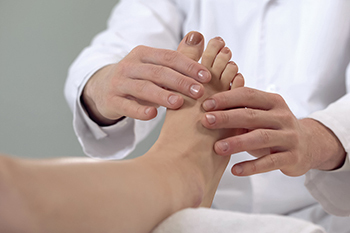
The ankle is a complex structure of bones, tendons, and ligaments that work together to carry your weight anytime you stand, walk, run, or play sports. If you have mobility problems, there are a number of exercises that can strengthen the ankles and help to prevent injury. Ankle exercises can also improve stability and flexibility. Improving the stability of your ankles on a daily basis has other benefits, such as helping you walk properly and preventing knee and hip injuries. Stiff or tight ankles can make it more difficult to flex and extend the foot, which inhibits your ability to walk uphill. Weak ankles can add to the risk of a sprain or other injury, when the joint gives way while walking or standing. Experts believe that strengthening the ankles can also help to increase bone density and ward off osteoarthritis. It can also help to reduce pressure on the joint and reduce the risk of falls. If you need information on exercises that can strengthen your ankles and increase their flexibility, please consult a podiatrist.
Ankle pain can be caused by a number of problems and may be potentially serious. If you have ankle pain, consult with Dr. Steven Schwartz from Pennsylvania. Our doctor will assess your condition and provide you with quality foot and ankle treatment.
Ankle pain is any condition that causes pain in the ankle. Due to the fact that the ankle consists of tendons, muscles, bones, and ligaments, ankle pain can come from a number of different conditions.
Causes
The most common causes of ankle pain include:
- Types of arthritis (rheumatoid, osteoarthritis, and gout)
- Ankle sprains
- Broken ankles
- Achilles tendinitis
- Achilles tendon rupture
- Stress fractures
- Bursitis
- Tarsal tunnel syndrome
- Plantar fasciitis
Symptoms
Symptoms of ankle injury vary based upon the condition. Pain may include general pain and discomfort, swelling, aching, redness, bruising, burning or stabbing sensations, and/or loss of sensation.
Diagnosis
Due to the wide variety of potential causes of ankle pain, podiatrists will utilize a number of different methods to properly diagnose ankle pain. This can include asking for personal and family medical histories and of any recent injuries. Further diagnosis may include sensation tests, a physical examination, and potentially x-rays or other imaging tests.
Treatment
Just as the range of causes varies widely, so do treatments. Some more common treatments are rest, ice packs, keeping pressure off the foot, orthotics and braces, medication for inflammation and pain, and surgery.
If you have any questions, please feel free to contact our offices located in Chambersburg, and Mcconnellsburg, PA . We offer the newest diagnostic and treatment technologies for all your foot care needs.
What Do Cracked Heels Look Like
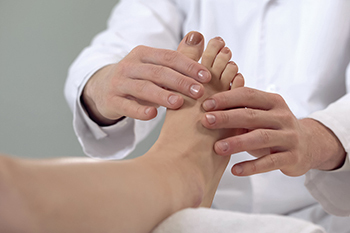
During the summer months when many people are concerned about how their feet look in sandals, you might hear talk about a foot condition known as cracked heels. This condition, also known as heel fissures, can occur as a result of dry weather and old age, among other causes. Cracked heels can look quite unsightly. Typically, an individual with this condition will exhibit deep cracks at the heel, with calluses surrounding the affected area that might also crack. In a case of heel fissures, the heel might even change colors, being slightly red. In some cases, a person with cracked heels might even see bleeding at the heel. Obviously, none of these visual symptoms are desirable. Prevent or cure cracked heels today by making an appointment with a podiatrist.
Cracked heels are unsightly and can cause further damage to your shoes and feet. If you have any concerns, contact Dr. Steven Schwartz from Pennsylvania. Our doctor can provide the care you need to keep you pain-free and on your feet.
Cracked Heels
Cracked heels appear unappealing and can make it harder for you walk around in sandals. Aside from looking unpleasant, cracked heels can also tear stockings, socks, and wear out your shoes. There are several methods to help restore a cracked heel and prevent further damage.
How Do You Get Them?
Dry skin is the number one culprit in creating cracked heels. Many athletes, walkers, joggers, and even swimmers suffer from cracked heels. Age and skin oil production play a role to getting cracked heels as well.
Promote Healing
Over the counter medicines can help, especially for those that need instant relief or who suffer from chronic dry feet.
Wear Socks – Wearing socks with medicated creams helps lock in moisture.
Moisturizers – Applying both day and night will help alleviate dryness which causes cracking.
Pumice Stones – These exfoliate and remove dead skin, which allows for smoother moisturizer application and better absorption into the skin.
Change in Diet
Eating healthy with a well-balanced diet will give the skin a fresh and radiant look. Your body responds to the kinds of food you ingest. Omega-3 fatty acids and zinc supplements can also revitalize skin tissue.
Most importantly, seek professional help if unsure how to proceed in treating cracked heels. A podiatrist will help you with any questions or information needed.
If you have any questions, please feel free to contact our offices located in Chambersburg, and Mcconnellsburg, PA . We offer the newest diagnostic and treatment technologies for all your foot care needs.
Facts About Gout
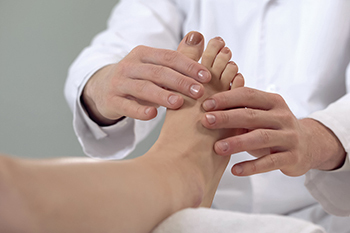
Gout is a form of arthritis, or inflammation, caused by a buildup of uric acid in the system. The main symptoms are redness, swelling, pain, and tenderness in a joint. The joint at the base of the big toe is commonly affected by gout. The range of motion in the joint decreases and even the slightest touch can cause extreme pain. Certain medications, dietary choices, drinking alcohol and sugary beverages, age, and genetics can play a part in the development of gout. Eating foods rich in purines, such as red meat and seafood, can increase the risk. People with diabetes, thyroid problems, and high blood pressure are also at a higher risk of gout. Men over 40 and menopausal women are more at risk as well. Medication and lifestyle changes are large factors in holding off gout. Corticosteroids and non-steroidal anti-inflammatory medications may be prescribed by a podiatrist to help reduce the pain and inflammation. In addition, certain medications can help to reduce uric acid production and eliminate it from the body. Please make an appointment with a podiatrist for additional treatment options for gout.
Gout is a foot condition that requires certain treatment and care. If you are seeking treatment, contact Dr. Steven Schwartz from Pennsylvania. Our doctor will treat your foot and ankle needs.
What Is Gout?
Gout is a type of arthritis caused by a buildup of uric acid in the bloodstream. It often develops in the foot, especially the big toe area, although it can manifest in other parts of the body as well. Gout can make walking and standing very painful and is especially common in diabetics and the obese.
People typically get gout because of a poor diet. Genetic predisposition is also a factor. The children of parents who have had gout frequently have a chance of developing it themselves.
Gout can easily be identified by redness and inflammation of the big toe and the surrounding areas of the foot. Other symptoms include extreme fatigue, joint pain, and running high fevers. Sometimes corticosteroid drugs can be prescribed to treat gout, but the best way to combat this disease is to get more exercise and eat a better diet.
If you have any questions please feel free to contact our offices located in Chambersburg, and Mcconnellsburg, PA . We offer the newest diagnostic and treatment technologies for all your foot and ankle needs.
Is Surgery Necessary to Treat Stress Fractures?

A stress fracture is a hairline fracture that commonly happens in the foot and may be prevalent among people who enjoy running. It occurs as a result of repeated stress the foot endures from physical activity, and the pain can gradually worsen if it is not treated promptly. It is suggested to temporarily cease the activity that caused the fracture, and relief may come from frequently elevating and resting the foot. Research has shown that people who are deficient in vitamin D or calcium may be susceptible to getting stress fractures, and it is advised to increase these types of supplements, if applicable. Additionally, when crutches are used, healing may be accelerated as the weight is kept off of the affected foot. If the fracture is severe, surgery may be necessary for permanent healing. The full recovery period for stress fracture surgery can be up to eight weeks, and low-impact activities can be performed as the healing takes place. If you think you may have a stress fracture, please consult with a podiatrist who can properly evaluate your foot, and offer treatment options that are correct for you.
Activities where too much pressure is put on the feet can cause stress fractures. To learn more, contact Dr. Steven Schwartz from Pennsylvania. Our doctor can provide the care you need to keep your pain free and on your feet.
Dealing with Stress Fractures of the Foot and Ankle
Stress fractures occur in the foot and ankle when muscles in these areas weaken from too much or too little use. The feet and ankles then lose support when walking or running from the impact of the ground. Since there is no protection, the bones receive the full impact of each step. Stress on the feet can cause cracks to form in the bones, thus creating stress fractures.
What Are Stress Fractures?
Stress fractures occur frequently in individuals whose daily activities cause great impact on the feet and ankles. Stress factors are most common among:
- Runners
- People affected with Osteoporosis
- Tennis or basketball players
- Gymnasts
- High impact workouts
Symptoms
Pain from the fractures occur in the area of the fractures and can be constant or intermittent. It will often cause sharp or dull pain with swelling and tenderness. Engaging in any kind of activity which involves high impact will aggravate pain.
If you have any questions please feel free to contact our offices located in Chambersburg, and Mcconnellsburg, PA . We offer the newest diagnostic and treatment technologies for all your foot and ankle needs.


